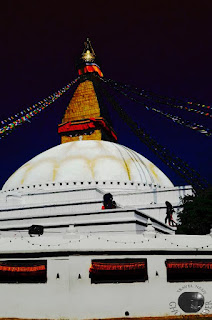Boudhanath (Devanagari, Nepali: बौद्धनाथ) (likewise called Boudha, Bauddhanāth or Bauddhanath or the Khāsa Caitya) is a stupa in Kathmandu, Nepal. It is known as Khāsti in Nepal Bhasa, Jyarung Khashor in Tibetan dialect (Tibetan: བྱ་རུང་ཁ་ཤོར། Wylie: bya rung kha shor) or as Bauddha by speakers of Nepali. Located around 11 km (6.8 mi) from the inside and northeastern edges of Kathmandu, the stupa's huge mandala makes it one of the biggest round stupas in Nepal.
The Buddhist stupa of Boudhanath rules the horizon. The antiquated Stupa is one of the biggest on the planet. The convergence of extensive populaces of exiles from Tibet has seen the development of more than 50 Tibetan Gompas (Monasteries) around Boudhanath. Starting at 1979, Boudhanath is an UNESCO World Heritage Site. Alongside Swayambhunath, it is a standout amongst the most prominent visitor locales in the Kathmandu zone.
The Stupa is on the old exchange course from Tibet which enters the Kathmandu Valley by the town of Sankhu in the upper east corner, goes by Boudnath Stupa to the antiquated and littler stupa of Cā-bahī (frequently called 'Little Boudnath'). It at that point turns straightforwardly south, heading over the Bagmati stream to Patan - in this manner bypassing the primary city of Kathmandu (which was a later foundation). Tibetan traders have rested and offered petitions here for a long time. At the point when displaced people entered Nepal from Tibet in the 1950s, many chose to live around Boudhanath. The Stupa is said to bury the remaining parts of Kassapa Buddha.
The Buddhist stupa of Boudhanath rules the horizon. The antiquated Stupa is one of the biggest on the planet. The convergence of extensive populaces of exiles from Tibet has seen the development of more than 50 Tibetan Gompas (Monasteries) around Boudhanath. Starting at 1979, Boudhanath is an UNESCO World Heritage Site. Alongside Swayambhunath, it is a standout amongst the most prominent visitor locales in the Kathmandu zone.
The Stupa is on the old exchange course from Tibet which enters the Kathmandu Valley by the town of Sankhu in the upper east corner, goes by Boudnath Stupa to the antiquated and littler stupa of Cā-bahī (frequently called 'Little Boudnath'). It at that point turns straightforwardly south, heading over the Bagmati stream to Patan - in this manner bypassing the primary city of Kathmandu (which was a later foundation). Tibetan traders have rested and offered petitions here for a long time. At the point when displaced people entered Nepal from Tibet in the 1950s, many chose to live around Boudhanath. The Stupa is said to bury the remaining parts of Kassapa Buddha.

No comments:
Post a Comment